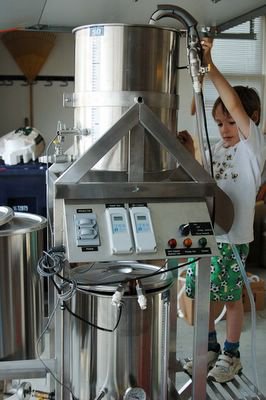Brewing Day, Part 1
Once everything was CLEAN and ready to go and all the ingredients were weighed/measured and ready, one of the first steps was to add water (which we passed through an in-line filter) to the MASH kettle. We heated this water to 168 oF before adding the grains for mashing (the process of soaking the grains so that the starches are converted to sugars.
The SPARGE water, below the mash, was also heated to 168 oF so that it could be used to run through the grain bed and help convert and extract the sugars. The hot SPARGE kettle helped keep the MASH kettle at the correct temperature. Water was pumped up from the SPARGE to the MASH through a rubber tube and then dispersed into the grain bed by a circular copper tube with holes. The last picture in this section shows a closeup of the sparge bed. If you look carefully, you can see the circular copper tube.
After about 90 min of mashing, the liquid (called wort) was ready for the boil. The liquid was drained off through an opening at the bottom of the MASH kettle and into the BOIL kettle. During the boil, various amounts of hops were added at different times... I will elaborate on this another time. I will try to explain the process more fully when we brew another batch, but this time around, I was also busy cleaning the garage, and not taking notes on such things as which ingredients were used and how much.
I will also talk about the fermentation process in a quick overview for this batch and in more detail when we get to another batch. I would like to do a more thorough job on this part of the website, but I have to remember that WOODLANDS SPRING (see link on the right) is my higher priority.








